
South Tufa
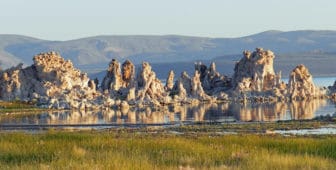
South Tufa is home to one of the largest tufa groves at the lake, and it is a great place to learn about Mono Lake’s unique ecosystem. An easy interpretive trail leads from the parking area to the shore of Mono Lake.
During the summer, free naturalist guided tours are offered daily, and on Saturdays and Sundays the rest of the year. Check here for details on tours and to reserve your spot. You can also access a self-guided tour.
South Tufa is a Federal Fee Area: adults are $3.00, children under 16 are free. National Parks Annual Passes are valid here. There is no shade, so bring a hat and drinking water. To get to South Tufa, turn onto Highway 120 East from Highway 395, drive approximately five miles and turn left at the signs for South Tufa. Keep left at the fork in the dirt road.
Navy Beach
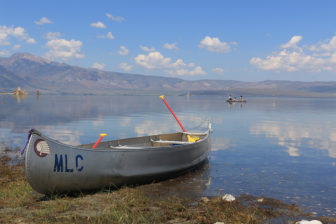
Navy Beach is the best place to launch kayaks, canoes, and paddleboards because of the proximity of the small parking area to the shore. It is also a great place to swim in Mono Lake because of the soft beach and gentle slope.
The Mono Lake Committee offers canoe tours on weekends in the summer that launch from Navy Beach. To get to Navy Beach, turn onto Highway 120 East from Highway 395, drive approximately five miles and turn left at the signs for South Tufa. Keep right at the fork in the dirt road. Parking is limited, so please consider unloading boats, then parking at South Tufa and using the short connecting walking trail.
Panum Crater
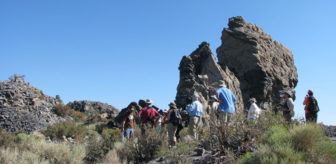
Panum Crater and the Mono Craters volcanic chain should not be missed by anyone interested in geology. Most accessible is Panum Crater, the northernmost and youngest of the chain of volcanoes. There are two hiking trails at Panum Crater: the rim trail, a longer trail around the edge of the crater in soft sand, and a shorter trail that climbs to the top of the plug dome and offers spectacular views of the entire Mono Basin. Panum is reached via a short dirt road, off Highway 120 East about three miles east of Highway 395.
Lee Vining
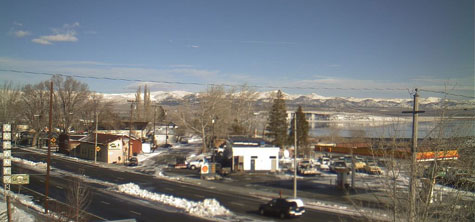
The town of Lee Vining is minutes away from Tioga Pass and Yosemite National Park, the ghost town of Bodie, and Mono Lake, making it a great home base for travels in the Eastern Sierra. Motels, restaurants, service stations, a market, churches, and other visitor services are available. More information is available on the Lee Vining Chamber of Commerce website.
While in Lee Vining, visit the Mono Lake Committee Information Center & Bookstore (houses the Chamber of Commerce), the Mono Basin Scenic Area Visitor Center, and the Mono Basin Historical Society Museum. Each offers interpretive displays, information, and friendly staff to help acquaint you with the area.
Old Marina
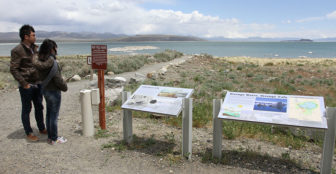
Old Marina has an astounding view of Mono Lake’s islands, quick access to the water’s edge, and an accessible path leading along the lakeshore on the David Gaines Memorial Boardwalk. A 1.5-mile trail connects Old Marina to the Mono Basin Scenic Area Visitor Center. A fee is required to visit Old Marina. No pets are allowed on the boardwalk.
If you’ve already visited South Tufa, you may notice some of the tufa towers at Old Marina look slightly different than those at South Tufa. Many of the tufa towers at Old Marina are actually pumice-block tufa. When Negit, the darker and smaller island erupted, large pieces of pumice floated across Mono Lake and eventually moored themselves on the lake shore. Once the pumice made it to shore, the same calcium and carbonate reaction that form tufa towers; occurred on the large pumice blocks, creating the pumice-block tufa we see at Old Marina.
Old Marina is where the historical Mono Lake Bike-A-Thons ended and rehydration ceremonies occurred. In this event, cyclists scooped vials of water from the reflecting pool in front of the Los Angeles Department of Water & Power’s headquarters in downtown Los Angeles and biked to Mono Lake, bringing the water “home” and pouring it directly into Mono Lake in a “rehydration ceremony,” while raising money to support the Mono Lake Committee’s efforts.
Mono Lake County Park
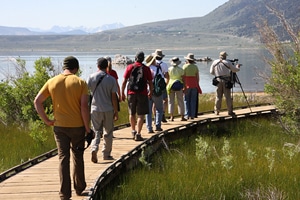
County Park is, like South Tufa, a great introduction to Mono Lake’s unique waters and tufa towers.
Note: The Inn Fire, which burned in May 2025, destroyed the State Reserve boardwalk below County Park. The lawn and restrooms are open but the boardwalk area is closed. Find more information here.
An easy trail and boardwalk meander to the lake through the willows and marsh of the Mono Lake Tufa State Natural Reserve (between the park and the lake), filled with waving grasses, colorful wildflowers, and delicate tufa towers.
At the lake, shorebirds feeding on the abundant aquatic life provide excellent opportunities for birding and general sightseeing. Nestled along a small stream and shaded by cottonwood trees, County Park is an idyllic picnic spot. It has restrooms, drinking water, picnic tables, and a playground for the enjoyment of all. It is located just off Highway 395 on Cemetery Road, five miles north of Lee Vining. Throughout summer months, birding tours are offered twice a week; check the list of interpretive programs to see if they are available during your visit. Dogs are allowed in the park but not on the boardwalk.
County Park has also been the setting of important displays of activism. State budget cuts threatened closing state parks—including the boardwalk through the Mono Lake State Natural Reserve below Mono Lake County Park—as well as many interpretive programs that teach visitors about Mono Lake. Mono Lake Committee members and friends gathered at the County Park boardwalk during the annual Mono Basin Bird Chautauqua to show their support for California State Parks.
Bodie State Historic Park
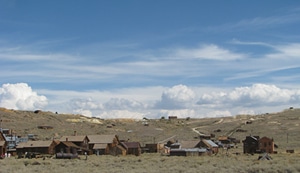
Bodie State Historic Park is one of the best preserved ghost towns in the United States, with the many buildings kept in a state of “arrested decay.”
Gold was discovered at Bodie in 1859, and by the 1870s it boasted three breweries and dozens of saloons and dance halls. There was more gambling, drinking, and shooting than any other mining camp. Those lawless days come alive as you wander through Bodie’s deserted buildings. Bodie is considered to be the best, and most well-preserved, historic ghost town in the country. Bodie reached a population of about 10,000 by 1879, but today only a few State Park Rangers live there year-round.
Bodie is a 45-minute drive from Lee Vining. The park is open 9:00am to 4:00pm from November 1 to May 14, and open 9:00am to 6:00pm from May 15 to October 31. Summer is the best time to visit; over-snow travel may be required to reach the park during the winter months. Bodie is one of the coldest places in the country—in 1999 it had the coldest temperature on 71 days of the year! Bodie charges an entrance fee of $8.00 per adult age 18+ and $5.00 per child ages 4–17 (no charge for infants). There are no services within 14 miles of the park so bring drinking water and snacks. For more information call (760) 647-6445.
